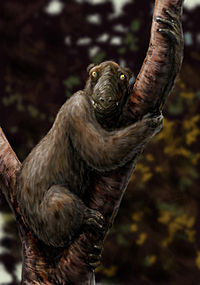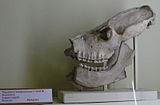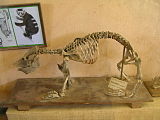- Koala lemur
-
Koala lemur[1] 
Megaladapis edwardsi Conservation status Scientific classification Kingdom: Animalia Phylum: Chordata Class: Mammalia Order: Primates Suborder: Strepsirrhini Infraorder: Lemuriformes Family: † Megaladapidae Genus: † Megaladapis
Forsyth Major, 1894Paleospecies Subgenus Peloriadapis
- M. edwardsi
Subgenus Megaladapis
- M. madagascariensis
- M. grandidieri
Koala lemurs, genus Megaladapis,[1][2] belong to the family Megaladapidae, consisting of three extinct species of lemurs that once inhabited the island of Madagascar. The largest measured between 1.3 to 1.5 m (4 to 5 ft) in length.
Contents
Appearance and habits
Megaladapis was quite different from any living lemur. Its body was squat and built like that of the modern koala. Its long arms and fingers were specialized for grasping trees, while its legs were splayed for vertical climbing. Additionally, its head was unlike any other primate, most strikingly, its eyes were located on the sides of its skull, instead of being placed forward on the skull like all other primates. Its long canine teeth and a cow-like jaw, formed a tapering snout. Its jaw muscles were powerful for chewing through the tough native vegetation. Its body weight reached a total of 50 kilograms (110 lb). The shape of its skull was unique among all known primates, with a nasal region which showed similarities to those of rhinoceros, what was probably a feature combined with an enlarged upper lip for grasping leaves.[citation needed]
Its tree-grasping attributes probably made Megaladapis vulnerable to changes to the forests of Madagascar. A thousand years before the arrival of the first humans, the island was struck by a prolonged drought. According to ecologist David Burney, the result, for the koala lemur, would have been a gradual thinning out of its forest home as it gave way to a more open and wooded environment. This would have forced forest dwelling animals to descend to the ground to compete for resources in a way in which they had not had to before.[citation needed]
When humans arrived, between 1,500 and 2,000 years ago, the archaeological record shows that they cleared large areas of the island using "slash-and-burn" techniques. This would have added even more pressure on the giant lemurs, and other mega fauna. Unable to adapt to the environmental changes and the presence of humans, Megaladapis became extinct approximately 500 years ago.[citation needed]
Cultural references
It is often believed that Malagasy legends of the tretretretre or tratratratra, an extinct animal, refer to Megaladapis, but the details of these tales, notably the "human-like" face of the animal, match the related Palaeopropithecus much better.[3]
Gallery
Images of Megaladapis Megaladapis edwardsi skeletonSkull of M. madagascariensis.M. grandidieri skeletonInaccurate 1902 life restoration of M. madagascariensisInaccurate 1902 life restoration of M. madagascariensisSee also
Other extinct lemurs:
- Archaeoindris
- Archaeolemur
- Hadropithecus
- Pachylemur
- Palaeopropithecus
References
- ^ a b Mittermeier, Russell A., et al. (2006). Lemurs of Madagascar (2nd Edition ed.). Conservation International. pp. 46–49. ISBN 1-881173-88-7.
- ^ Nowak, Ronald M. (1999). Walker's Primates of the World. Johns Hopkins University Press. p. 83. ISBN 0-8018-6251-5.
- ^ Simons, E. L. (2003). "Chapter 6: Lemurs: Old and New". In Goodman, S. M.; Benstead, J. P.. Natural Change and Human Impact in Madagascar. University of Chicago Press. pp. 142–166. ISBN 0-226-30306-3.
External links
Categories:- Subfossil lemurs
Wikimedia Foundation. 2010.



